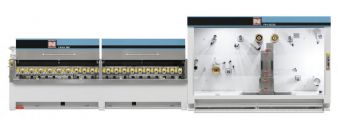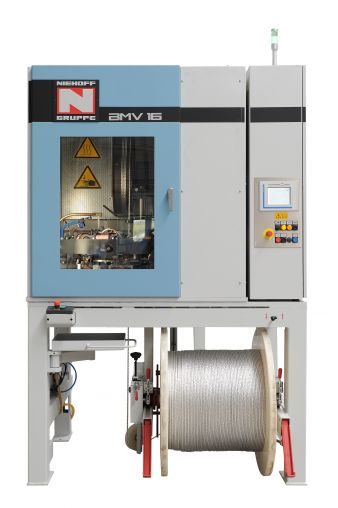Multiwire drawing: innovative, reliable, smart
The exhibits of Maschinenfabrik Niehoff at “wire” 2020 feature several world technological firsts and include: a multiwire drawing line type “MMH 112+RM 202+S 632”, a “BMV 16” type rotary braiding machine with integrated “BAS 800” take-up and pay-off unit, and a “D 632” type double twist bunching machine with “ARP 630” pay off.

Multiwire drawing line type “MMH 112+RM 202+S 632”. © Niehoff
The multiwire drawing line type “MMH 112+RM 202+S 632” developed for copper and aluminum wires embodies a new generation of multiwire drawing lines. Constructional details, with high precision manufactured components and the sophisticated control technology enable the system to run at speeds of up to 40m/s. The result is an increased production output, while at the same time less energy is consumed in relation to the production volume.
Installation of the line is much more comfortable and faster. The drawing machine and the annealer stand on integrated vibration-damping machine feet, the spooler comes mounted on a base plate. This makes special foundation or grouting superfluous. The same applies to the alignment of the motors, since all motors used in the line are integrated.
What is innovative in the “MMH 112” multiwire drawing machine are in particular special design improvements creating real benefits such as great ease of operation and maintenance as well as energy savings and quality increase. The MMH 112 uses specifically inclined die holders for a straight die inlet enabling finest wire quality and less wire breaks. The integrated water-cooled motors facilitate a perfect sealing system between drawing emulsion and gearbox, and components like final die holders and wire pointing device have been optimized for easy access and handling.
Based on a modular system, the MMH 112 type machines are available with one or two levels and in three different lengths for a maximum of 21, 25 or 31 drafts according to the specific tasks of the users. The MMH 112 can draw wire in 31 drafts from 1.8mm to 0.1mm diameter.
The new type “RM 202” multiwire resistance annealer also takes part in energy saving. Depending on the wire diameter, it uses the field-proven 2/3-zone-system with or without wire reheating which is expressed in an optimum wire drying with economical use of energy. A new annealing power supply MF-technology reduces energy losses by up to 10% and the power factor (cos phi) is higher than 0.95. Thus, idle power is almost eliminated. Another new feature is the optimized wire movement controlled by a random generator. It has the effect that the wear on the contact tubes is more evenly spread resulting in a longer life of the contact tubes. Another innovation is that the accessibility has been improved which simplifies maintenance.
Also the dynamic single spooler type “S 632” shows some new features: the complete electrical equipment and the electronics are installed in the machine housing, and the spool shaft is connected with a direct drive. Therefore, belts are no longer required, which simplifies maintenance. The machine is delivered mounted on a base plate and can be moved quickly if necessary.
The result: High-quality wire
The wires drawn on the MMH 112 line show highly homogeneous characteristics and narrowly tolerated properties along their entire length. These properties surpass the most demanding specifications and processing requirements. Wires drawn on MMH lines can be processed to multiwire bundles with outstanding characteristics and are ideally suited for final applications or further processing into high-quality strands, ropes or braids.
Braiding: 14% more output and materials savings
The “BMV 16” rotary braiding machine is equipped with three patented innovations. Niehoff is thus also in this area the leading provider of new developments. One innovation is that the machine can automatically increase the bobbin rpm from 175rpm to a maximum value of 200rpm and additionally reduce the frequency of the lubrication intervals. The result is an increased production output of 14%. For a certain order volume, the user needs less time, and simultaneously the braiding point is less contaminated with oil.

Rotary braiding machine type “BMV 16”. © Niehoff
The second innovation concerns the coverage ratio and the associated consumption of braiding wire. A cable entering the braiding machine can vary in diameter. If the user wants to maintain a certain minimum coverage even with an increasing cable diameter, he up to now had to set a higher coverage ratio. The patented Niehoff solution makes it possible to apply only as much braiding wire as necessary and thus to save material.
An installed measuring device permanently measures the diameter of the incoming cable before it enters the inlet of the braiding area and regulates the take-off speed accordingly. In this way, the coverage ratio of the cable is always kept constant at the preset value (for example 80%). This margin often is 15% or even more!
Coverage is documented and can be proven to customers – in process quality control.
The third innovation is the regulation of the wire tension. The WTC (Wire Tension Controlling) system regulates via the dancer position the wire tension of the braiding bobbins, from full to empty condition. Thus, all braiding wires are applied to the cable with uniform tension. The result is a uniform braid along the whole length of the product. This means that faultless shieldings can be produced, which is particularly required for applications in the area of autonomous driving. Wire tension is documented and can be proven to customers – in process quality control.
Several monitoring systems enable an unattended operation for extended periods and without frequent operator intervention.
The BMV 16 braider designed for 16 bobbins and equipped with a “BAS 800” take-up and pay-off unit is designed for processing of bare or plated round or flat wire made from copper, aluminum or stainless steel with single-wire diameters ranging from 0.05mm to 0.3mm (40 … 28 1/2 AWG) as well as artificial yarn and fibers.
Bunching: Perfect traverse and short amortisation time (RoI)
The latest “D 632” type double twist bunching machine combined with an ARP 630 pay-off provides many process control features and is one of Niehoff´s best-sellers. Three special features make the operation of this machine very rewarding for the user: the single-bow design with the Eco-Bow energy-saving bow, the automatic traverse system NBAT and the regulated wire tension, regardless of the spool filling. Due to the regulated winding tension and the automatic laying, each spool is perfectly filled, the strands can be payed-off without problems in subsequent operations even at high speeds and there are less scrap and fewer complaints. The production parameters such as winding tension, lay length and lay numbers can be documented so that the user of a D 632 can prove his customer top quality.
Due to the automatic mode of operation, it is possible for one operator to look after more machines. As a result, labour costs can be reduced.
Additional costs can be saved if the machine produces bunches with very tight tolerances. This means that only the minimally required copper cross-section is used. – not more! Considering the high production reliability of the machine, the purchase of a D 632 pays itself off relatively quickly. Niehoff offers interested parties when visiting the trade fair to calculate their specific ROI.
The D 632 is ideally suited for processing copper alloy fine wires such as CuSn0.3 into bunches for automotive wires. Using the “Stretch Forming and Straightening technology”, the machine avoids the crowning and spiraling effect typical for certain copper alloys.
The machine demonstrated at the trade fair will process a bundle with 7 wires made of the alloy CuSn0.3 into strands with the design 7 x 0.156mm = 0.13mm².
The D 632 is able to produce strands with 0.09mm² to 6.00mm² (AWG 27 ½ ... 9 ½) cross section and a steplessly variable lay length of 6 to 100 mm. The maximum number of twists is 7,000twists/min and the maximum production speed 300m/min (984fpm).
Comprehensive services
On the upper floor, Niehoff’s after-sales-service will be introducing its offer of spare parts with the „Niehoff Original+“ label. These products help increase the efficiency of Niehoff systems over the long term. There, the visitors will also learn how they can benefit from Niehoff’s digitization concept.
The Niehoff Digital Assistant+ informs the users of Niehoff systems about the condition of machinery, provides machine and process data in real time and simplifies the identification of and ordering of spare parts. The services offered by the Niehoff after-sales-service also include modernizing older Niehoff machinery and equippping it with new controls and control cabinets. Last but not least, Niehoff supports its customers with mainenance and service contracts.
Complete solutions from a single source
Maschinenfabrik Niehoff develops and builds with an experience of nearly 70 years machinery – with the exception of extruders – needed for the production and the downstream processing of non-ferrous wires into automotive, power, data and special cables.
In addition, the portfolio contains technical assistance by professional specialists who speak the customers´ languages. The reliable supply with original Niehoff wear parts and spare parts, machinery inspection, refurbishment and maintenance measures as well as machine operator and maintenance training courses complete the range of services. The.Niehoff Group offers custom-tailored solutions from development and planning to turnkey projects of complete cable factories.
Niehoff Endex North America, Inc. (NENA), a wholly owned subsidiary of the Niehoff Group, with manufacturing and engineering capabilities in NJ, USA, is responsible for the sales, supply, and service of the entire Niehoff product range in the USA, Canada & Mexico.
The Niehoff Group with over 850 employees worldwide is comprised of its headquarters, six manufacturing subsidiaries (in Brazil, the US, the Czech Republic, India, China, and Sweden) as well as sales and service centers in Japan, Singapore and Russia.
Source: Wire




